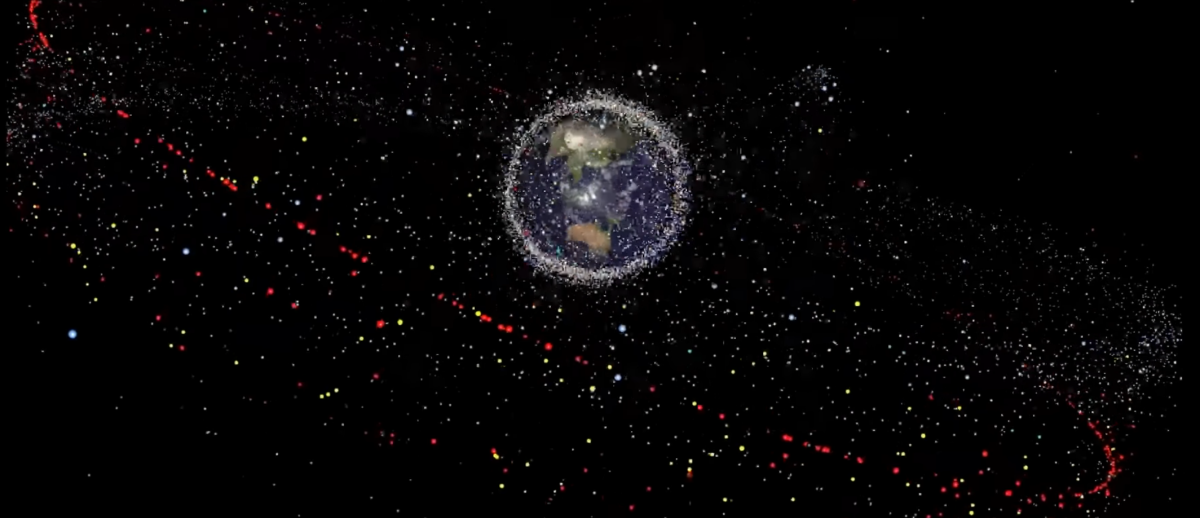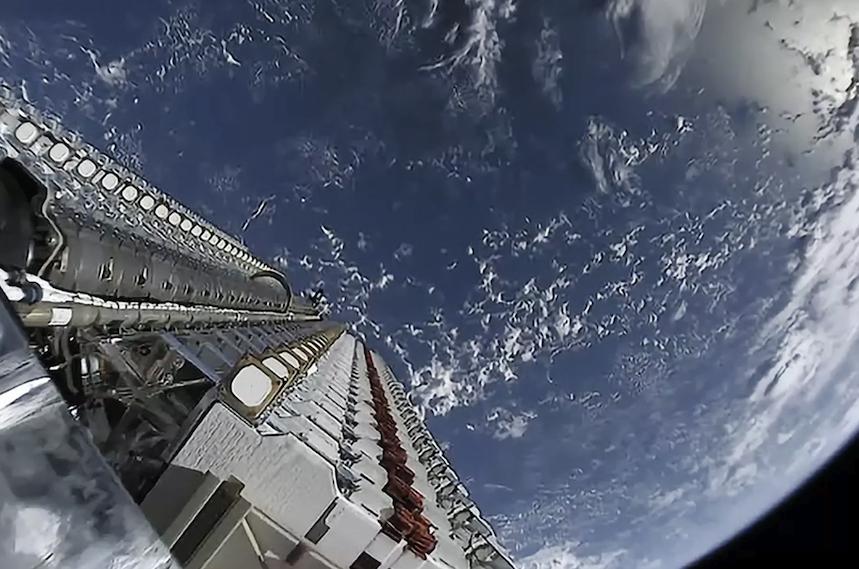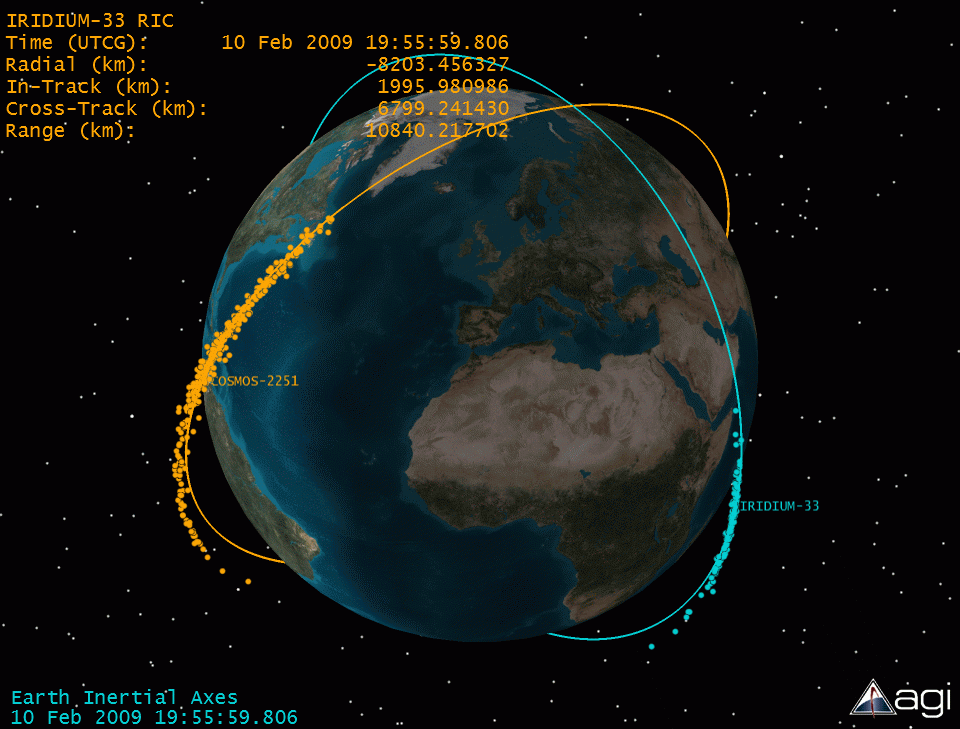Outer Space Sustainability: Legal Dilemmas on the “Final Frontier”
archive


Computer animation depicting the distribution of space debris (resident space objects, or RSOs) of various types orbiting the earth. (Source: European Space Agency)
Outer Space Sustainability: Legal Dilemmas on the “Final Frontier”
Outer space is getting crowded as a “Wild West” boom in billionaire-funded Internet satellite constellations raise the specter of delaying or even grounding commercial and exploration missions due to space debris. High-tech billionaires Jeff Bezos, Elon Musk, and Mark Zuckerberg, among others, are already beginning to deploy swarms of small satellites into low-earth orbits that will extend Internet connectivity to billions of residents in rural areas of Africa, Asia, and other regions beyond the reach of terrestrial networks. On paper, the total number of proposed low-orbit satellite constellations could add up to over 100,000 satellites if they all succeeded to launch. This represents a giant leap from the current number of about 2,500 larger satellites operating mainly in higher orbits.
Technological advances that make ultra-small satellites and re-usable launch systems (such as Musk’s SpaceX or Bezos’s Blue Origin) economically feasible now threaten to make orbital regions unusable. Imagine trying to launch humans to the moon and beyond if the ascent into orbit becomes even more risky. Already, launch planning involves careful selection of a trajectory that avoids hitting any of these small but potentially deadly satellites and other pieces of orbiting debris leftover from earlier rocket launches. Amid the Gold Rush fever to orbit, the problem according to cooler scientific heads is finding out “where’s the sheriff in the ‘Final Frontier’”? The explosion in the number of proposed low-earth orbit satellite constellations is exposing the regulatory gap between traditional “hard” law space treaties put in place at the beginning of the space age and the emerging 21st Century legal regime that relies on non-binding “soft” law arrangements for a much more proprietary outer space marketplace. The space race now is whether humankind will be able to reach the goal of planetary sustainability before a space debris nightmare emerges as a “tragedy of the commons.”
Six decades ago, hard law international treaties established a regulatory framework for the few governmental space programs funded and operated by the Soviet Union, the United States, and European governments. Today, non-governmental commercial space companies are operating under voluntary soft law rules of the road that expose the deficiencies of the original treaties to empower regulatory supervision of the expanding commercial orbital presence. Technical solutions to space debris require a “sustainable” system of governance accomplished by increasing the costs of non-compliance by all entities, governmental and commercial alike.

Screen grab of live footage from SpaceX's deployment of its first 60 Starlink broadband internet satellites on May 24, 2019. (Source: SpaceX)
In the opening decade of the 21st Century, the problem of space debris became the poster child for an outer space regulatory environment that, like space itself, had become “congested, contested, and competitive.” This prescient observation by U.S. Deputy Secretary of Defense Schulte in 2011 was confirmed on March 27, 2019, as India became the fourth country (After China, Russia, and the United States) to demonstrate its anti-satellite capability by using its own Shakti system to intentionally destroy another Indian satellite, and in the process, creating another massive cloud of orbital debris. On the same day, NASA Administrator Jim Bridenstine, testifying before the U.S. Congress, described the problem thusly:
Debris ends up being there for a long time. If we wreck space, we're not getting it back… And it's also important to note that creating debris fields intentionally is wrong... because some people like to test anti-satellite capabilities intentionally and create orbital debris fields that we today are still dealing with. And those same countries come to us for space situational awareness because of the debris field that they themselves created… And that's being provided by the American taxpayer, not just to them, but to the entire world for free… The entire world [has to] step up and say, 'If you're going to do this, you're going to pay a consequence.' And right now, the consequence is not being paid.1 [emphasis added]
The Shakti debris cloud underlines the mounting concern for the “congested, contested, and competitive” challenges posed not only by space debris (removal), but also spectrum interference (i.e., “jamming”), and space traffic management (collision prediction and prevention) for the long-term sustainability of the open access regime promised by the 1967 Outer Space Treaty (OST) and later agreements.2 But even more glaring is how the Shakti test is evidence of the low political or legal cost for entities flouting compliance of existing “soft” rules established to minimize space debris in particular, and the “legal sustainability” of the outer space regime in general.
The Problem of “Sustainability”
International legal regime sustainability can be measured by its capacity to fill in the regulatory gaps posed by hard law treaties with voluntary soft law “rules of the road” that enjoy near universal compliance. The long-term sustainability of outer space as an open and accessible global commons may depend, paradoxically, on the “legal sustainability” of the regime designed for its evolving governance. It is a “paradox” when one considers that outer space, a physical realm subject to the laws of physics and chemistry, is actually governed by a “virtual” realm operating according to the laws promulgated and enforced by human beings. While legal ambiguity may create opportunities for diplomatic compromises in the drafting of treaty space law, the orbital laws of space debris are unambiguous, as underlined by the destruction of the U.S. Iridium satellite following a collision with the Russian Kosmos 2511 satellite in 2009.3

Graphic depicting Iridium 33 and Cosmos 2251 orbits and debris three hours post-collision on February 10, 2009. (Source: T.S. Kelso, celestrak.com)
The “sustainability” of the evolving legal regime for outer space is primarily determined by the degree to which entities comply with the regime’s rules and regulatory actions, even if they are ostensibly “voluntary” or “non-binding.” Currently, the biggest challenges are posed by the shift to non-binding arrangements as outer space is accessed increasingly by non-governmental, commercial entities. However, the Shakti incident shows that governmental entities are likewise able to ignore voluntary guidelines with little or no consequence, as pointed out by NASA Administrator Bridenstine. In other words, voluntary guidelines may pose minimal transaction costs for non-complying entities; more binding guidelines would exact a higher transaction (political) cost as non-compliance violates higher ranked legal (i.e., hard law) norms.
Economics Nobel Laureate Oliver Williamson’s transaction cost theory posits that by raising the political, and ultimately, legal costs of non-compliance, the existing “tragedy of the commons” may be minimized within a “tweaked” legal framework that shifts soft law voluntary guidelines into categories of hard law, such as those defined in the International Court of Justice Statute—that is, general principles and customary international law (CIL). States violating the UN’s recently approved voluntary Long-Term Sustainability (LTS) Guidelines for space debris could face much higher political costs for non-compliance if such guidelines were considered as mirroring customary international legal norms.4
National Legislation as International Law
University of Cologne Space Law Professor Stephan Hobe asserts that a state’s membership in the United Nations may require that state to pass national legislation implementing UN policy, including the UN’s recently approved (2019) Long Term Sustainability (LTS) Guidelines for preventing and removing space debris. However, the question remains open whether national legislation could assume and exert a wider international applicability and/or jurisdiction. In other words, if many states passed similar pieces of national legislation applying the UN’s voluntary space debris guidelines, could such legislation serve as evidence of a generalized state practice approaching the threshold of customary international law? What could serve as the legal nexus for making such an assertion?
[T]he existing “tragedy of the commons” may be minimized within a “tweaked” legal framework that shifts soft law voluntary guidelines into categories of hard law...
An intriguing proposal is to consider general principles as constituting, in effect, international customary norms operating as one of the sources of international law.5 Legal scholar Diane Howard suggests that by comparing and assembling the common elements of national laws and regulations pertaining to space activities, one “may distill a general principle of international law.” Although such national laws and regulations may be directed solely at national entities under the territorial and/or sovereign jurisdiction of the country’s governmental bodies, they could at the same time be considered both a “general principle” as well as a “general practice” of international law guiding judges’ decisions at the International Court of Justice.
Next Steps
Technology billionaires and Internet markets are moving faster than lawmakers and legal regimes. International non-binding soft law arrangements, designed to fill the regulatory gaps left by the five hard law space treaties addressing space debris, lack enforcement mechanisms. In order to address these shortcomings, non-compliance transaction costs could be imposed by international legal arbitration panels and courts that are based on widespread, i.e., customary, international legal norms. Scholars have begun to assemble a compendium of national laws that reveal certain common themes, such as space debris mitigation and remediation, using the LTS Guidelines as a primary filter for establishing which themes already enjoy international recognition. In this way, national legislation itself would serve both as a general principle guiding such national legislation as well as a general practice of states accepted as customary international law. CIL would not be limited by the actions of states on the international level, but would also encompass legislative and regulatory actions of states on a predominately national level of action and jurisdiction. Only then would the satellite boom begin to be reined in by space sheriffs in the “Wild West” of low-earth orbit.
1. Salazar, Doris Elin. (2019). India's Anti-Satellite Missile Test Is a Big Deal. Here's Why.” Space.com (https://www.space.com/india-anti-satellite-test-significance.html, accessed April 1, 2019).
2. Treaty on Principles Governing the Activities of States in the Exploration and Use of Outer Space, including the Moon and Other Celestial Bodies, (the “Outer Space Treaty”) Adopted by the General Assembly in its resolution 2222 (XXI), opened for signature on 27 January 1967, entered into force on 10 October 1967. Agreement on the Rescue of Astronauts, the Return of Astronauts and the Return of Objects Launched into Outer Space, Adopted by the General Assembly in its resolution 2345 (XXII), opened for signature on 22 April 1968, entered into force on 3 December 1968. Convention on International Liability for Damage Caused by Space Objects (resolution 2777 (XXVI), annex)—adopted on 29 November 1971, opened for signature on 29 March 1972, entered into force on 1 September 1972; Convention on Registration of Objects Launched into Outer Space (resolution 3235 (XXIX), annex)—adopted on 12 November 1974, opened for signature on 14 January 1975, entered into force on 15 September 1976. The 1979 Moon Agreement has been ratified by only a small number of states (16) and is not considered to be fully in force (Agreement Governing the Activities of States on the Moon and Other Celestial Bodies, Adoption by the General Assembly in its resolution 34/68 on 5 December 1979, opened for signature on 18 December 1979, entered into force on 11 July 1984). Source: http://www.unoosa.org/documents/pdf/spacelaw/treatystatus/AC105_C2_2016_CRP03E.pdf (Accessed on July 20, 2016).
3. Martinez, L. (2011). “Is There Space for the UN in Bonn? Perspectives on the Sustainability of Outer Space and Cyberspace for UN Organizations,” in Nina Simone Huerter and Sebastian Bruns (eds.), Nachhaltig ins 21. Jahrhundert. 15 Jahre UNO Stadt Bonn. Bonn: Bouvier Verlag.
4. See, Williamson, O. (1996). The Mechanisms of Governance. Oxford: Oxford; and Hardin, G. (1968). "The Tragedy of the Commons" Science, 162: 1243–1248; and, United Nations. (2018). Statute of the International Court of Justice, Article 38. (Source: http://www.icj-cij.org/en/statute, accessed June 19, 2018).
5. U.S. Department of Commerce General Counsel Diane Howard, from notes taken by L. Martinez at UNCOPUOS, June 19, 2018, Vienna. See, D. Howard, “Distilling General Principles of International Space Law,” IAC-13, E7.5. See also, Martinez, L. (2019). “Legal Regime Sustainability in Outer Space: Theory and Practice,” forthcoming in Global Sustainability, Cambridge University Press.



